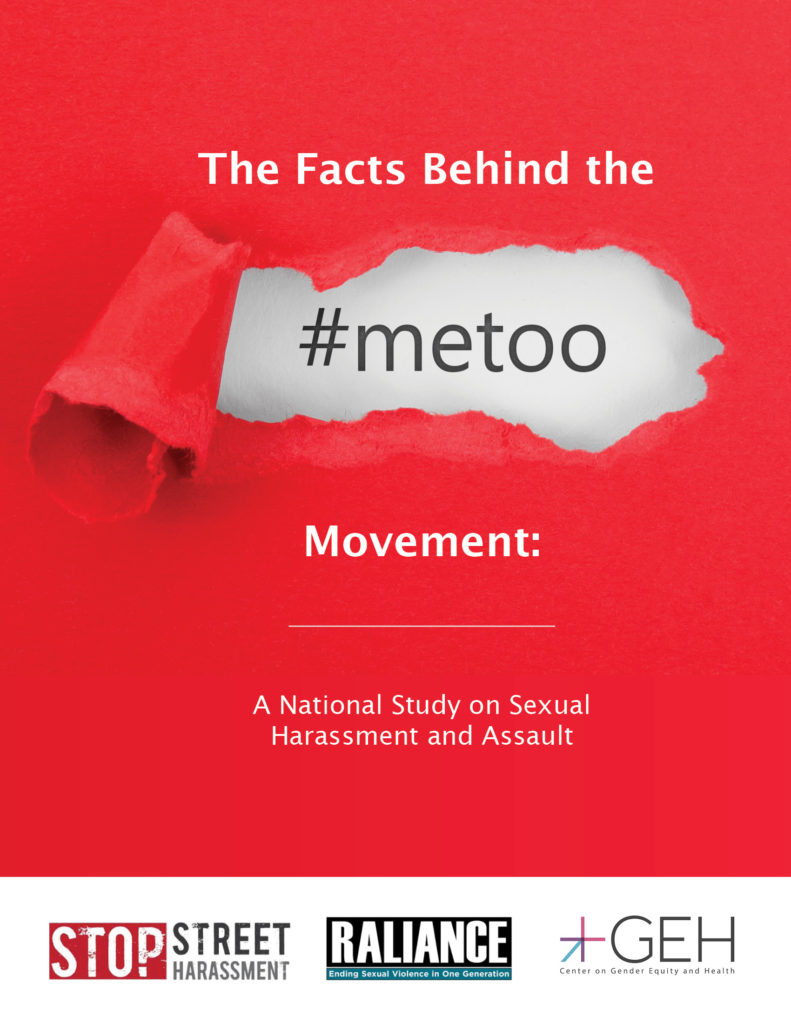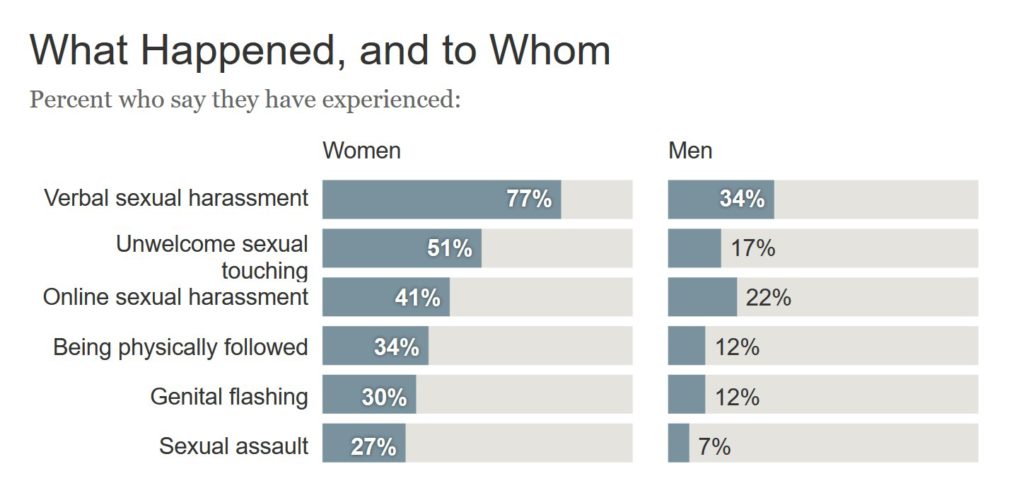

February 21, 2018: In January 2018, SSH commissioned a 2,000-person, nationally representative survey on sexual harassment and assault, conducted by GfK. It found that nationwide, 81% of women and 43% of men reported experiencing some form of sexual harassment and/or assault in their lifetime.


While verbal sexual harassment was the most common form (77% of women and 34% of men), an alarming 51% of women and 17% of men said they were touched or groped in an unwelcome way, and 27% of women and 7% of men survived sexual assault.
Pro bono data analysis for the survey was completed by the UC San Diego Center on Gender Equity and Health. Their team, the team at Raliance and a dozen advisory committee members offered input and invaluable help throughout the process.
MEDIA:
Contact SSH at StopStreetHarassment@Gmail.com for interview requests
WHY:
In October 2017, numerous women in Hollywood came forward with sexual abuse allegations against Harvey Weinstein, an incredibly influential film producer with the power to make or break careers. While stories about sexual abuse are not new, the climate of the country was such that the stories about Weinstein and the individuals and institutions complicit with his abusive behaviors hit a nerve.
Long before this national moment, Tarana Burke created a “Me Too” movement in 2007 to help victims of sexual harassment and assault. Initially inadvertently building on Burke’s work, on October 15, 2017, actress Alyssa Milano invited people to use a #MeToo hashtag to show just how widespread sexual harassment and assault are in the United States beyond Weinstein and the stories in the headlines. Soon, millions of people had used the hashtag. Within a few days, Facebook reported that 45% of users in the US had at least one friend who had posted #MeToo on their timeline.
Now, four months later, dozens of high-profile men have been fired or resigned from their jobs in the entertainment, arts, political, sports, and business industries because of women and some men who came forward with their allegations of abuse. In many cases the accounts of abuse were confirmed by multiple victims sharing similar stories about the same perpetrator, showing a clear pattern of abuse and predatory behavior, which was all too often ignored by individuals and institutions who failed to hold these perpetrators accountable.
Many of the #MeToo headlines and media stories have focused on wealthy and/or white women’s experiences, specifically in the workplace. Part of the reason for this oversight is the lack of recent data documenting the entirety of the problem.
Initially in October 2017, SSH received inquiries from journalists asking if there was a study that tracked a single statistic on the full scope of sexual abuses women face, including sexual harassment and assault, across locations like workplaces and public spaces. As it turned out, existing research was segmented (such as SSH’s 2014 national study on sexual harassment in public spaces or AAUW’s 2011 national study on sexual harassment in grades 7-12 ) and often dated. Further, while the Centers for Disease Control and Prevention (CDC) has a comprehensive study, National Intimate Partner and Sexual Violence Survey (NISVS) that encompasses many of the behaviors tracked in this study, it focuses more heavily on physical forms and does not distinguish respondents’ experiences by locations like public spaces, workplaces, schools and homes.
So, when asked for one, comprehensive figure across locations, the answer was complicated and not easily ascertainable. They also wanted to see where these abuses most often occur and who demographically was at greater risk and while the CDC NISVS has demographic information for sexual violence, it again was not available across the locations where such violence typically occurs. Nor does it break down who perpetrators are in relation to the people they harm. Now, thanks to the help of our partners, donors and advisory committee, we have that information.
This report contains the facts and figures behind the #MeToo movement and the stories so many people have shared. But the findings go beyond #MeToo.
The findings demonstrate that this is not just an issue that affects women; it affects any group that is marginalized. The findings show that sexual harassment and assault are abuses of power, disrespect, and disregard for human dignity. And, long after #MeToo fades away, these findings will remain to show how far we must go to ensure that everyone who lives in the United States feels free and safe from sexual abuse, from the time they are born until the time they die.
TOPICS:
The report covers information on these five main topics:
Demographic information is broken down by gender, race/ethnicity, sexual orientation, household income, disability, age, and region of the country for each section, when the sample size allowed.
DONORS:
Center on Gender Equity and Health, University of California, San Diego